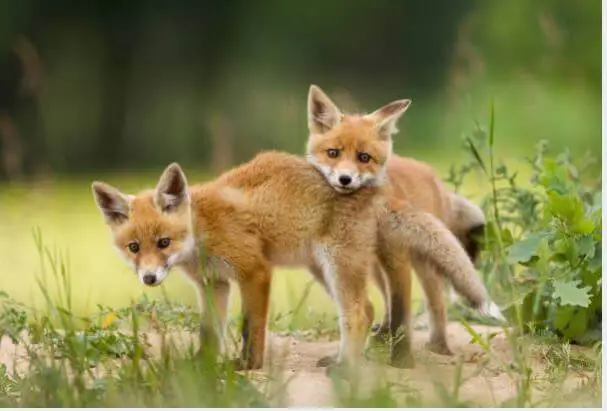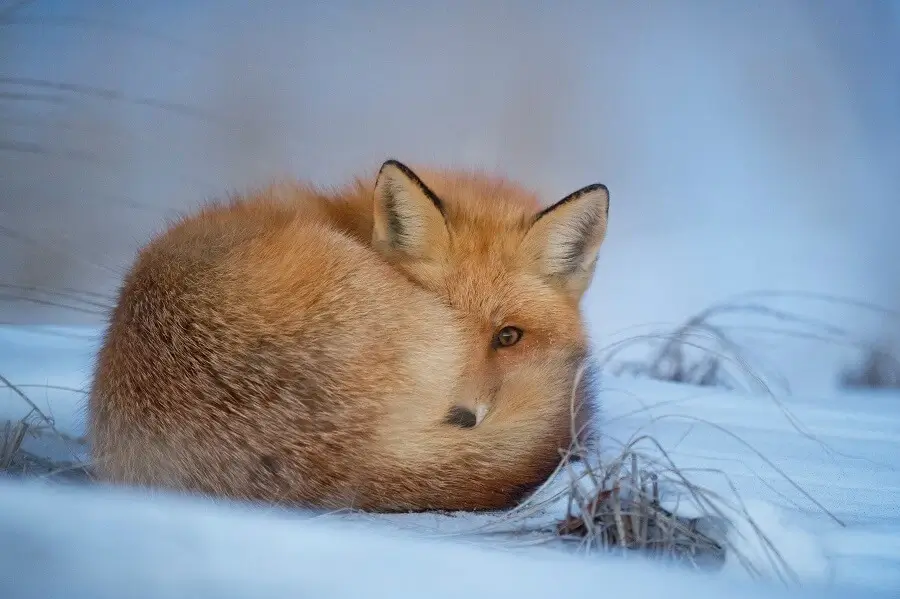Fox mating season is a fascinating time to gain insight into the reproductive behaviors and family lives of these widespread mammals. Getting an inside look at when foxes actually breed and raise their young reveals intriguing facts about their habits and biology that many never knew.
For an in-depth look at the fascinating world of fox mating season, including details on when they breed and the wild rituals involved, read on to learn more about the specific months these adorable creatures mate and when their kits are born.
When Does Fox Mating Season Start?
Foxes are seasonal breeders so they only mate during special windows of the year. Fox mating seasons usually occur in winter and spring months.

Mating Season for Red Foxes:
The breeding window of the common red fox falls between January and March, with most mating activity happening between January and February.
I also found that some red foxes living in warmer climates may start getting frisky as early as December, while those live in colder regions won’t start until late February or early March. Overall, the mating season for red foxes lasts around one month.
Mating Season of Grey Foxes:
In contrast to red foxes, gray foxes tend to mate a bit later, between February and April in most areas. Additionally, they also have a condensed breeding window of just 1-2 months.
After doing in depth research, I found that no matter the species, foxes follow natural seasonal cues particularly winter season for reproduction. Similarly, both red and gray foxes give birth to their babies in the spring, which allows them to feed and nurturing their kits in the whole summer to prepare for winter.
What Happens During Fox Mating Season?
Now that we know when foxes breed, the question is “what actually occurs during these lively spring mating rituals?” Although a number of fascinating behaviors characterize fox mating season, I have listed some important facts from battling for breeding rights, the actual copulation, and vocalizations:
- Male foxes, called dogs or reynards, fight over and establish breeding rights to female foxes, called vixens. The dominant male wins access to mate with the vixen.
- Foxes are polygamous, so male and female foxes always have multiple mating partners during breeding season.
- The male fox does not provide parental care to their partners and babies and also leaves their vixen shortly after mating. The male fox also does not help their vixen to raise the litter.
- Male foxes give off loud screaming noises during mating described as unearthly caterwauling. Similarly, the vixen also vocalizes with various yips and cries.
- Mating pairs remain “tied” or “locked” together for up to an hour.
- Foxes show impressive stamina, breeding repeatedly over several days to ensure pregnancy.
So, from the sounds to the competition for mates, wild fox mating ritual truly is an energetic spectacle. It results in the next generation of adorable fox kits to arrive in the spring.
Fox Reproduction and Fox Gestation Period

One big question around fox breeding season is: how long are foxes pregnant?
So, the answer of the above question is; after successful mating sessions in the early spring, according to the maryland.gov the vixen fox gestation period lasts 49-58 days, which is approximately 1.5 to 2 months. Similarly, Grey foxes average a 52–53 day pregnancy.
Litter Size of Foxes
Every fox specie has different litter size. Red foxes have 2-12 pups and on the other side Grey fox litters tend to be slightly smaller at 3-7 offspring. Overall, the average red fox litter contains 4-6 kits.
Average Weight of Baby Fox at Birth
The helpless fox babies weigh just 120 grams or about 4 ounces at the time of birth. They open their eyes at around 8-12 days old, and first leave the den when they’re about one month old. By fall, juveniles are mature enough to leave home and start their own families.
Fox Mating Compared to Wolves: Key Difference
Although foxes occupy some of the same habitats as their larger canid relatives, wolves. But fox mating seasons actually differ from wolf breeding in a few key ways:
- Foxes come into heat earlier than wolves, starting as early as December or January compared to late January for wolves.
- Fox breeding wraps up quicker in just 1-2 months, whereas wolves mate from late January through March.
- Wolves are monogamous, mating for life. Foxes are polygamous with multiple breeding partners.
- Male wolves help care for their pups. On the other hand, Male foxes do not stick around or aid in raising litters after mating.
So, while foxes and wolves are both prolific springtime breeders, wolves follow a later, longer mating season and have different family dynamics.
Challenges Foxes Face During Mating Season
Although foxes are prolific breeders, but they face some challenges during their matting season:
- As the habitats of foxes is shrinking, male foxes sometimes have to travel farther in search of unmated vixens, and also need to compete other males along the way.
- Urban foxes also face difficulty finding reproductive partners as they live in densely populated areas which don’t offer comfortable matting option to foxes.
- As foxes have short 1-2 month mating window, means both males and females need to be ready to breed at the right time before the season ends.
- I have also noticed that interbreeding with domestic dogs and coyotes also threatens the integrity of wild red fox genetics in some part of the world.
- Additionally, disease and high mortality rates in juvenile foxes is also a major factor to reduce breeding success. According the latest data, up to 80% of kits perish before reaching adulthood.
Although foxes are known for their adaptability, their wild mating rituals face modern obstacles. Therefore, Conservation efforts focused on protecting habitats, reducing urban conflicts, and monitoring populations are crucial for supporting fox reproduction.
Fox Mating Noises and Sounds
I know you are curious about the type of noise and sounds a fox make while matting. From the first stirrings of courtship to the high-pitched yips of newborn kits, fox vocalizations provide a window into their mating behaviors:
- Male foxes make a loud, shrieking scream during mating described as otherworldly. This attracts females and announces territorial dominance.
- The vixen makes excited yelping and squealing sounds when receptive to breeding. She growls and swats males away when unreceptive.
- Fox kits mewl softly during their first days after birth, progressing to louder whimpers and squeaks when hungry or in distress.
- By 4-5 weeks old, fox pups start making more adult-like noises like barks, growls, and howls while playing.
I tried to listen the fox mating noises and went into the wild and also got success. So, attuned listeners can discern fox needs and activities by identifying their breeding cries and sounds. These vocalizations are part of the wild spectacle that accompanies each spring fox mating season.
Conclusion
Gaining insight into the fox mating timeline provides intriguing perspective on the natural behaviors of these widespread mammals. From battling for mates, to birthing litters, to hitting those high mating screams, foxes put on quite a spectacle each breeding season. While the action happens out of sight for most of us, learning when foxes breed and how reveals new appreciation for the rich family lives of these wild creatures during spring’s sounds of courtship and new life.

